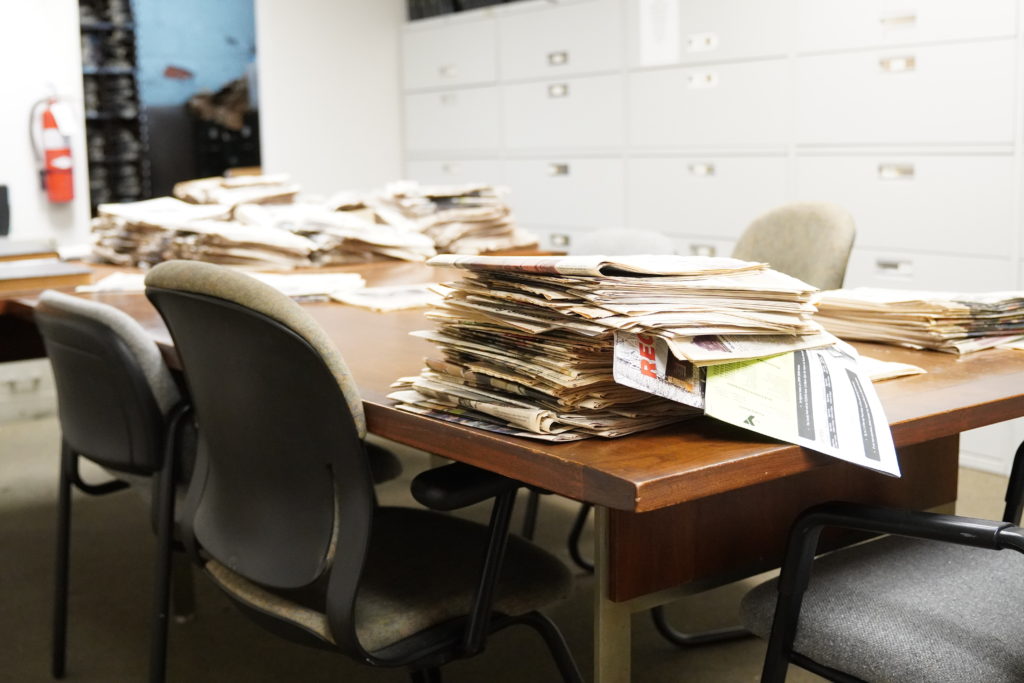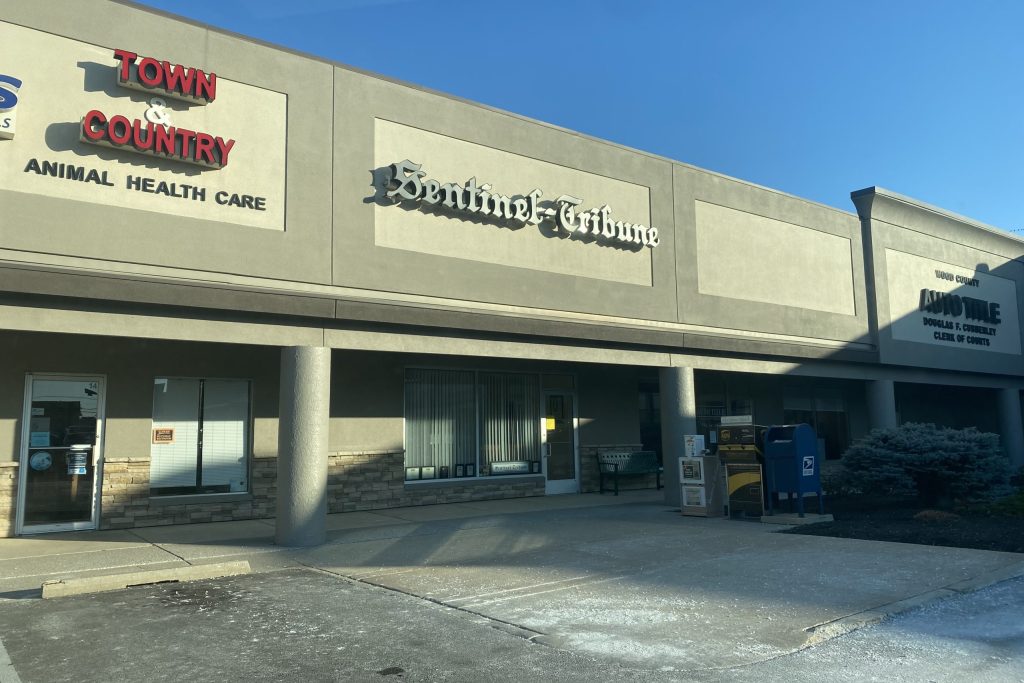News Desert Investigation
For one of my classes we did a group investigative project. My group looked into news deserts in the United States. We talked to many local journalists and others involved in media to see how disappearing newspapers affect the local communities.
Group members: Drew May, Owen Hnatyshyn, and Brain Weah


Local Newspapers Disappearing
Over recent years, local newspapers have increasingly grown smaller, many disappearing all together.
Newspapers have been forced to reduce their staff, which leads to reduced coverage for their communities. The University of North Carolina School of Media and Journalism found that the United States has lost almost 1,800 papers since 2004.
Ed Breen, who has worked as the editor of the Chronicle-Tribune in Marion, Indiana, the assistant managing editor at the Fort Wayne Journal Gazette and now works as a co-host for WBAT Radio in Marion, said that the local newspapers used to cover everything happening in the community. They covered the courtrooms, politics, government, entertainment, lifestyle, food and much more. Now, he said many of those things are gone.
“Every bit of it is gone. And I think the Chronicle-Tribune is now at a point where it publishes whatever walks in the door,” he said.
Due to the lack of coverage, many local communities don’t get the information they need to know the most. Breen said that many local newspapers don’t cover the important stories, like government or courtroom issues. They are unable to cover the stories that affect the people in their communities the most.
One of the main reasons coverage is down for local newspapers is their lack of reporters.
Debbie Rogers, the editor of the Sentinel-Tribune in Bowling Green, Ohio, said that when she first started working for the newspaper, she covered small town council meetings and school board meetings. Now, they don’t have enough reporters to cover those small towns at all.
“They’re just too small,” she said. “We just don’t have the resources to cover them.”
The inability to cover council meetings and school board meetings leaves communities uninformed of the things that affect their day-to-day lives. Rogers said that local communities don’t get the information they need about how their tax dollars are being spent.
“And I think that is our number one job in the news business is to show how your tax dollars are being spent,” Rogers said. “And that’s where the decisions are being made, at the council meetings and school board meetings. And unless you’re there you’re probably hearing a lot of gossip around town. Probably turning to Facebook.”
While information still gets around through social media and other methods, Rogers said often that information isn’t accurate.
A study done by the Pew Research Center shows that newspaper newsroom employment in the United States has fallen 57% between 2008 and 2020.
Both the Chronicle-Tribune and the Sentinel-Tribune have seen the number of reporters shrink drastically.
“By way of comparison, in my last day as an editor of the Chronicle-Tribune in 1995, I had 28 people on my staff in the newsroom of the Chronicle-Tribune,” Breen said. “I found out today that that newsroom is now closed, the few people that are there are using some other room in the building now.”
The Chronicle-Tribune now has one editor and a couple reporters who only put out a paper twice a week.
While the Sentinel-Tribune is doing slightly better than many other local newspapers as they still print five days a week and have a strong online presence, they have still shrunk from what they once were.
Rogers said that when she first started working for the Sentinel-Tribune, they used to have a huge facility as they had 20-25 people on the news staff, 15 on advertising, 10 in the print area, and a couple drivers who would deliver the paper each day. They have since moved to a smaller location and now only have five full time news people including herself and a couple stringers and part time people.
This decrease in reporters comes from layoffs due to lack of funds. Since digital news was first introduced, local newspapers have begun struggling with money. Digital media has limited the advertisements available to newspapers as well as shrunk their subscriber base.
Cassidy Grom, who interned at the New York Daily News and the Chronicle-Tribune and now works as a Communications Specialist in New Jersey, said newspapers struggle now because when the Internet first came around they didn’t charge people to read the news like they had before.
“And really, just in the past six, seven years, you’ve been seeing paywalls and they’re trying to recoup some of that money, but it doesn’t make sense. Right before the Internet their model is based on subscription money, like a paper lands on your doorstep and then suddenly the news is free,” she said. “How did they expect to make ends meet?”
Local newspapers have also seen a decrease in their subscribers as some people have become unhappy with the lack of coverage in their communities.
“We have a lot of very loyal readers who appreciate what we do, but we also hear quite a bit from people who think that we’re not doing what we were doing 40 years ago, and it’s hard, you can’t disagree with that,” Jared Keever, the managing editor of the Chronicle-Tribune, said. “And so you get locked into this kind of spiral where it’s like you lose subscribers and you lose the power of your subscription base.”
Lack of funds has also come from disappearing advertisements in newspapers.
Breen said that newspapers used to rely on advertisements, especially from automobile dealerships and real estate companies. He said automobile dealers used to buy pages every week in local newspapers. Now there are new ways for them to advertise, so they no longer rely on newspapers.
Real estate companies are similar, Breen said. Instead of publishing their ads in newspapers, they can now publish photos and videos online.
“So you had advertising base going away and you had reader base going away,” Breen said. “And when that took on cataclysmic proportions, newspapers couldn’t function.”
Newspapers Cutting Staff or Closing Across America
Throughout the United States newspapers are cutting their staffs and many are closing altogether.
Newspapers from every city and state are being affected no matter the size. The Pew Research Center found that in 2020 55% of large market newspapers with an average Sunday circulation of 250 thousand or more had to cut some of their staff. Around 27% of medium market papers experienced staff cuts and small market papers experienced 31%.
Gene Polincinski, Senior Fellow for the First Amendment at the Freedom Forum, said that all over America there are counties that have no news products at all. Even the places that do, he said are often only shells of what they once were. Instead of a regular newspaper, some places do mostly advertising or occasionally news releases.
Communities in these areas would be part of what most people consider a news desert. There is little to no news available in these areas.
“A news desert, like a real desert, doesn’t have to be totally devoid of life for it to be a desert,” Polincinski said.
Due to the lack of traditional news outlets, Polincinski said that people often don’t know the full scope of the things that are happening in their communities.
This lack of knowledge can affect communities in many ways, but Polincinski said most importantly it will affect how people vote for their local government officials. He said instead of voting based on facts from the news, people often vote based on who is the loudest. They don’t know the full story, so people vote based on one issue without knowing where the politician stands on all topics.
“Democracy depends on free press being there both to provide us with the information to self-govern, but also to be that watchdog of government so that it’s much more than just being around,” Polincinski said. “It actually to me has a constitutional role as well as this vital role in terms of how our country should operate.”
According to the surveys done by the Pew Research Center in 2019 and 2020, Americans who get their news from social media or another nontraditional news sources are less likely to get their facts right about politics and other major issues than those that have access to traditional news sites.
Government sites that offer information about politicians are available, but Polincinski said they still aren’t the same as regular news sites.
“And even with the best of intentions, government websites are not meant to be that sort of checks and balance journalistic enterprise, they provide data, they list services, but they’re not news sites,” he said.
News organizations that cover only state government and are funded by donations are beginning to pop up in 37 states, Polincinski said. While this is a start, he said that the concept still needs to be built upon as these sites are only writing for the whole state and not the individual communities within the state.
Traditional news organizations are decreasing all over the country. Polincinski said he thinks the only place in the country where news deserts are getting better or not appearing as quickly is New England.
“Communities are smaller and more traditional (in New England),” he said. “They support the high school, they shop locally and they buy a local product. But even those are fading. But I think the further west you get because of distance, smaller populations and cities, news deserts are just vast. So, it’s a huge growing problem.”
Ed Breen, who has worked as the editor of the Chronicle-Tribune in Marion, Indiana, the assistant managing editor at the Fort Wayne Journal Gazette and now works as a co-host for WBAT Radio in Marion, said that even the big cities that still have newspapers aren’t able to cover as much as they used to.
“The, what we used to think of as the big city newspapers, the big city newspapers are struggling just the way the small papers are,” he said. “They just have more ways to absorb the struggle.”
Local newspapers can’t cover what they used to, but Breen said the big newspapers are facing the same issues. He said those issues aren’t as obvious yet because the big newspapers have more resources and options than the smaller newspapers.
The struggles of traditional American newspapers, Breen said, has come from technology.
“What has led to the news deserts is a change, fundamental change in American life, in which we now get most of our information off of machines, devices,” he said.
Newspapers all over the United States are switching from print to online. Breen said most have not been successful with this switch. He said he believes the New York Times and the Washington Post are the few news sites that have successfully started delivering news electronically.
Despite the increase in news deserts across the country, Polincinski said he still has hope that traditional news organizations can be restored.
“I think it’s vital we find a way to restore, get rid of those news deserts,” he said. “I think it’s still possible to do it.”
Digital News Replacing Print
News coverage has changed drastically over time as digital news takes over for print newspapers.
Digital news has grown to become a common outlet in the lives of many Americans. A survey done in 2020 by the Pew Research Center found that 86% of adults in the United States get news from a smartphone, tablet or computer. Only 32% get their news from print newspapers.
Through these changes, newspaper companies have had to learn to work with digital sites. Many newspapers have closed over the past couple of years, but those that remain have had to start using online sites.
Debbie Rogers, editor at the Sentinel-Tribune in Bowling Green, Ohio, said that the newspaper now puts all their stories online before it goes into print. She said the people who read their online version may see a story first while the people who only read their print version may not see it for a couple of days.
Unlike many local newspapers, the Sentinel-Tribune has had more success with their online news. Rogers said they have a strong paywall that requires people to be a subscriber before they can read.
“I think it (online news) helps because your information is out there right away,” she said. “So it’s helped in that we’re out there more but it’s not, it’s different than just having a subscriber.”
Rogers said she expects things to continue to change as the younger generations get older.
“I think it’s gonna go more digital. The people who want to read our paper are definitely older,” she said. “The younger generation just really doesn’t want much to do with an actual newspaper.”
As online news becomes more popular, changes in the way news is presented are beginning to come with it.
Cassidy Grom, who interned at the New York Daily News and the Chronicle-Tribune in Marion, Indiana and now works as a Communications Specialist in New Jersey, said that she expects news to become more interactive for consumers.
“Print is completely dead,” she said. “I think we’re headed to a more design centric interactive news experience.”
Interactive news has already begun to appear, with videos and graphics being found on many online news sites. Grom said she expects to see more databases, graphics, maps and other interactive items appear in the future.
While interactive news will provide many new resources for consumers, Grom said she thinks it may be a problem for small newspapers that can’t provide those interactive elements.
“I believe the news sources nationally, like the Times, CNN, those places as well as larger state newspapers are going to trend more towards interactive news with databases and maps and graphics to keep people engaged and informed,” she said. “And those are great, but unfortunately, people are gonna come to expect that and when the Chronicle publishes a three thousand word story with like two pictures and no fancy maps or graphics, people’s attention spans have just gone.”
Small newspapers have already started to disappear around the country and those that remain will have to find new ways to tell their news online.
Creating interactive news for small newspapers will be a challenge, but Grom said she thinks it will allow for opportunities for younger generations.
“So how do you get local journalists the time and support they need to make some of that interactive stuff? That’s a challenge too,” she said. “And that’s an opportunity for people our age to kind of come in and think of stories different, like not necessarily in the normal, giant article platform.”
Despite the new opportunities digital news presents, it has caused many problems for newspapers already and those problems are likely to continue. The University of North Carolina School of Media and Journalism found that in the U.S. more than one in five newspapers have closed in the last decade and a half. Along with that, they also found that half of the counties in the country have only one newspaper that tries to cover all the local communities and almost 200 counties have no newspaper at all.
Currently there isn’t any way to stop the decrease in newspapers. Grom said she believes the best way to fix the current issues is through government funding. The issue with that fix, she said, is that it would only work if politicians believe that unbiased journalism is important.
“Frankly, politicians I’ve worked for in the past year, they’re excited, they want their community to be informed, but they can’t stand the idea that they might also get scrutinized,” she said. “They want it essentially to just be a feel-good news service.”
For journalism to function properly, politicians may have to be scrutinized at times. Grom said convincing them to agree to that may be the most difficult part.
The government may not want to spend more money to save newsrooms, but Grom said they won’t necessarily have to. Instead of creating a new bill to save newspapers, she said they can use money and budgets they already have.
Along with government funding, Grom said she thinks it would help to educate government officials on how to smartly engage with the press. She said many of the officials she has been around don’t know how to tell when someone is a legitimate journalist, so educating them on the media world would help them support news organizations.
Despite her ideas, Grom said she doesn’t expect nationwide fixes through government anytime soon.
Government investment isn’t the only option for saving small newspapers. Ed Breen, who has worked as the editor of the Chronicle-Tribune, the assistant managing editor at the Fort Wayne Journal Gazette and now works as a co-host for WBAT Radio in Marion, said that the big corporations who run many of the local newspapers could work to invest more into their communities.
“That investment in the communities in which you were doing business would grow the newspaper,” he said. “It might bring back lost readers. It might bring back new readers, bring new readers in, and it certainly would be serving the community.”
Despite the decrease of print news and local newspapers, Rogers said she still has a lot of hope for the future.
“I’ve really had a lot of hope for it and the last couple of years we’ve seen a lot of good journalism students come up and reach out to us for stringer opportunities,” she said. “And I can say too that each one of those students has got either a job with us in the company or gone to the Toledo market or another area paper so that was the main thing I was concerned about.”
